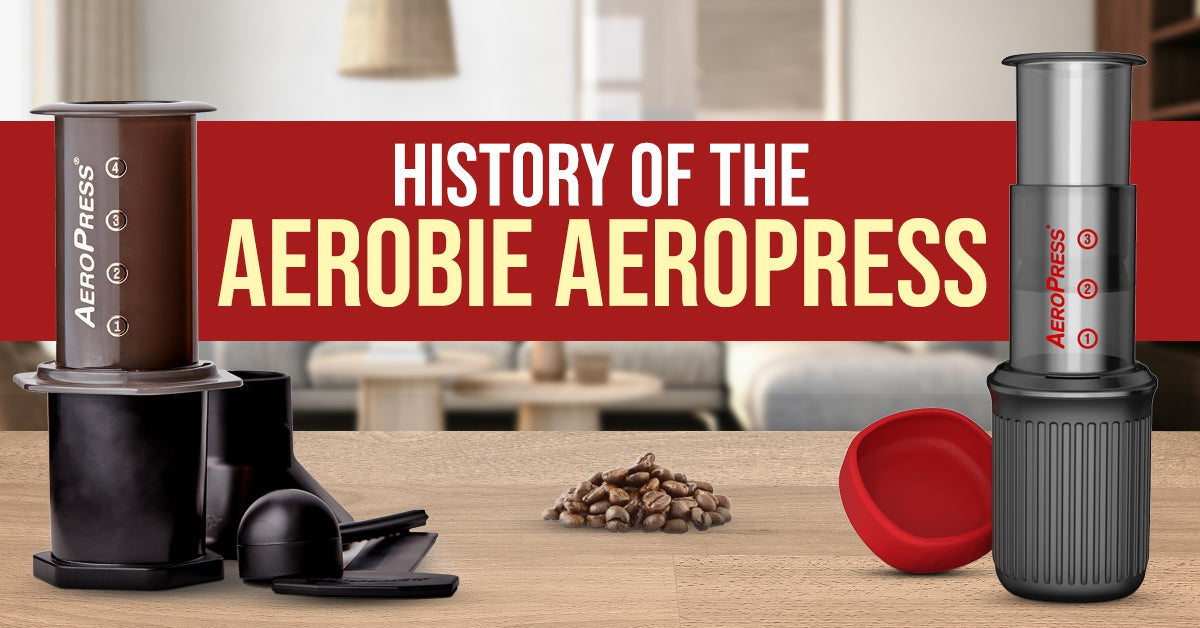
History of The Aerobie Aeropress
The Aeropress: part Frisbee, part coffee lovers dream. Ok, it isn’t part Frisbee, but it does have a unique connection to the world of leisure sorts, being invented by the same guy. In a lot of ways, the products are similar - the Aerobie was initially treated as a novelty at first, but soon went on to become one of the most iconic products of the 1980’s.
And to an extent, the same is true of the Aeropress. Initially viewed by coffee lovers as no more than a novelty (and then a fad), before you could say ‘espresso’ it had found it’s way into the cupboards, bags, and hearts and minds of coffee lovers everywhere. There's even a World AeroPress Championship where experts go head to head brewing coffee.
So why so successful? The answer is obvious - this simple, easy to use device makes great coffee. Read on and we’ll tell you all about the history, design, and the many advantages of the Aeropress, as well as how to brew coffee with Aeropress. You'll be able to brew better coffee than many more expensive systems, in fact. But that is only one of its many pluses.
The Invention Of The Aeropress
 In the 1960's Alan Adler was working as an engineer in the private sector, designing things that the average person rarely sees: submarine and nuclear reactor controls, instrumentation systems for military aircraft, and optics.
In the 1960's Alan Adler was working as an engineer in the private sector, designing things that the average person rarely sees: submarine and nuclear reactor controls, instrumentation systems for military aircraft, and optics.
His interests often led to new inventions, so it’s no surprise that he saw room for improvement with the Frisbee. Applying his knowledge of physics and engineering, he created a superior aerodynamic moulded ring that could fly much farther with less effort. So, the Aerobee was born, allowing him to pursue other passions.
Fast forward another 20 years, when, as an amateur astronomer in the early 2000s, Alan Adler invents a new type of paraboloid mirror and wrote a computer program, Sec, that assisted the way astronomers select secondary mirrors. But this was small fry compared to the newest problem he had to solve - he wanted to know how to make better coffee, cheap. A genius and coffee lover, when he turned his attention to coffee brewing, the results would be spectacular. Based in California, where the Aeropress is made, he got to work.
Developing The Aeropress
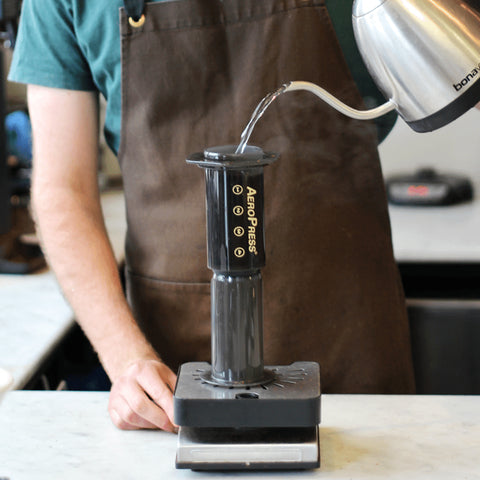 Understanding that long brew times were the issue, he fell on the idea of using pressure. Leaning a little on the espresso process, and also the French Press, he designed a system whereby the coffee would only extract for 10-15 secs. Of course, the key difference to the espresso machine was its simplicity. The maker would simply apply the pressure directly to the device, much like with a french press.
Understanding that long brew times were the issue, he fell on the idea of using pressure. Leaning a little on the espresso process, and also the French Press, he designed a system whereby the coffee would only extract for 10-15 secs. Of course, the key difference to the espresso machine was its simplicity. The maker would simply apply the pressure directly to the device, much like with a french press.
Taking it to trade shows, the coffee world was sceptical at first. Despite Alan’s extraordinary achievements in other fields (he also designed a yacht which won the Transpac race from San Francisco to Hawaii), the Aeropress was dismissed as a novelty, mainly due to its association with the Aerobie.
However, the coffee world would soon be forced to sit up and take notice, as consumers began raving about this amazing new coffee making system. Boasting the ability to brew espresso-style coffee in 10-15 secs, and at a fraction of the price, this machine even had the seemingly magical ability to self-clean during use!
And so here we are, in a world dominated by the Aeropress, with tens of thousands of units sold and the World Aeropress Championship a staple in the coffee calendar.
How Does The Aeropress Work?
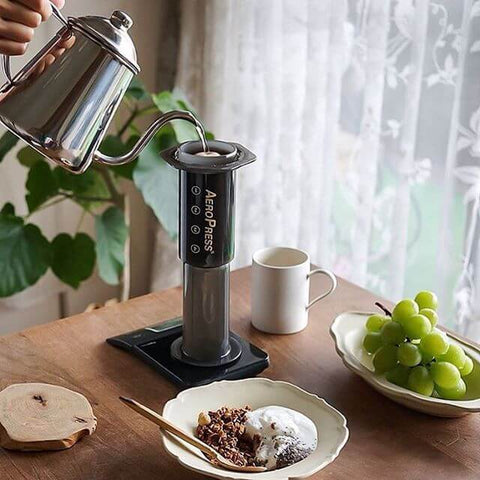 Resembling a large syringe, the Alan Adler's Aeropress has two cylinders which fit together forming an airtight seal. Before use, the cap needs to be removed from the main chamber and the filter added. These originally were only paper filters, but you can now also buy metal filters with a much expanded lifespan. Although the paper filters alone can be used up to 25 times.
Resembling a large syringe, the Alan Adler's Aeropress has two cylinders which fit together forming an airtight seal. Before use, the cap needs to be removed from the main chamber and the filter added. These originally were only paper filters, but you can now also buy metal filters with a much expanded lifespan. Although the paper filters alone can be used up to 25 times.
Once the cap is replaced, the chamber is placed on top of a sturdy mug (or jug). Coffee is added to the chamber, and at this stage it is recommended you shake the chamber to even out the grounds.
For a ‘normal’ hot coffee, hot water is added up to the first mark on the chamber, at around 80 degrees. Then the user stirs for 5-15 secs depending on taste, before adding the plunger and applying pressure. When the plunger hits the coffee grounds, you’re done. Then, you can eject the puck and enjoy your coffee. The added advantage here is that as the plunger is pushed down, it cleans the chamber as it goes! Magic.
Why Is Aeropress So Good?
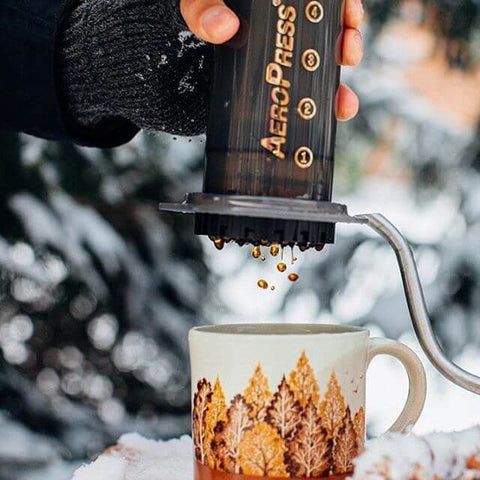 The first thing to say is, it’s because it makes great coffee. We’ll get to that in a bit. Alan Adler boiled down the concept of espresso making to it’s simplest form, and in the process made something that not only competes for quality, but absolutely destroys the espresso machine on cost, and usability.
The first thing to say is, it’s because it makes great coffee. We’ll get to that in a bit. Alan Adler boiled down the concept of espresso making to it’s simplest form, and in the process made something that not only competes for quality, but absolutely destroys the espresso machine on cost, and usability.
The Aeropress is also the most portable system out there, as the plastic will take some real abuse. So you can travel the world with the Aeropress easily and have great coffee always, which is why these are nowadays especially popular with digital nomads.
Probably the best thing for many coffee lovers though is that the Aeropress is flexible. You have control over nearly every aspect of coffee making. If you want a longer extraction, easy, or if you want to use a coarser grind for example, sure. You can vary the temperature of the water, the amount of coffee you use, and how much pressure you apply to force the hot water through the grounds.
In fact, the AeroPress is so adaptable it can be used to make cold drip coffee. This was never the inventor’s intention, but as more people got their hands on it and started messing around, a whole new world of possibilities opened up for this infinitely versatile coffee maker.
How Good Is Aeropress Coffee?
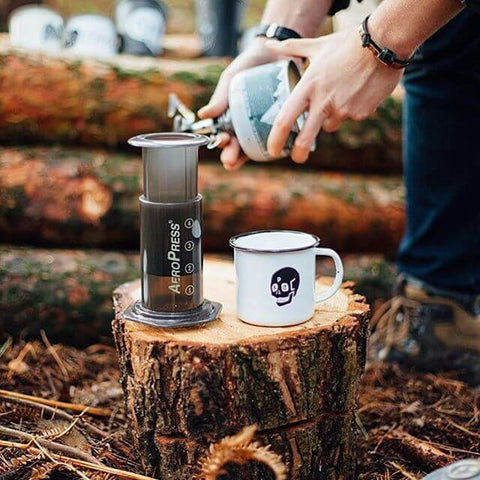 Simple - it’s as good as anything out there! Not dissimilar to espresso, it generally works out slightly weaker. But the world is your oyster with Aeropress - from espresso to cold drip, there is a world of different brews that can be made.
Simple - it’s as good as anything out there! Not dissimilar to espresso, it generally works out slightly weaker. But the world is your oyster with Aeropress - from espresso to cold drip, there is a world of different brews that can be made.
If you’ve never tried this coffee brewing method, now is the time. Barista Warehouse has not only the AeroPress but all the accessories you could possibly need, so check out our full range today!
 Same Day Dispatch
Same Day Dispatch